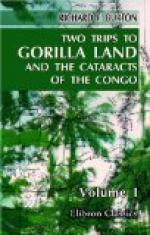In the cool of the morning Fitevanga, king of Mayyan, lectured me upon the short and simple annals of the Fan. In 1842 the first stragglers who had crossed the Sierra del Crystal are said to have been seen upon the head waters of the Gaboon. I cannot, however, but suspect that they are the “Paamways” of whom Bowdich ("Sketch of Gaboon,” p. 429) wrote in the beginning of the century, “All the natives on this route are said to be cannibals, the Paamways not so voraciously as the others, because they cultivate a large breed of dogs for their eating.” Mr. W. Winwood Reade suspects them to be an offshoot of the great Fulah race, and there is nothing in point of dialect to disprove what we must at present consider a pure conjecture. “The Fulah pronouns have striking analogies with those of the Yoruba, Accra, Ashantee, and Timmanee, and even of the great Kaffir class of dialects, which reaches from the equator to the Cape,” wrote the late learned E. Norris, in his “Introduction to the Grammar of the Fulah Language” (London: Harrison, 1854).
According to the people of the upper river the Fan were expelled by the Bati or Batti—not “Bari” as it has been written-from their ancient seats; and they are still pushing them seawards. The bushmen are said to live seven to ten short marches (seventy to a hundred miles) to the east, and are described by Mr. Tippet, whom they have visited, as a fine, tall, slender, and light-skinned people, who dress like the Fan, but without so much clothing, and who sharped the teeth of both sexes. Dr. Barth heard of the Bati, and Herr Petermann’s map describes them[FN#20] as “Pagans, reported to be of a white colour, and of beautiful shape, to live in houses made of clay, to wear cloth of their own making, and to hold a country from which a mountain is visible to the south-west, and close to the sea.” The range in question may be the Long Qua (Kwa), which continues the Camarones block to the north-east, and the Batis may have passed south-westward from Southern Adamawa.




